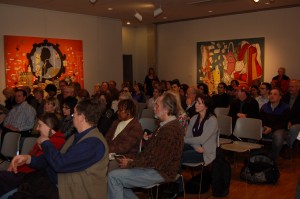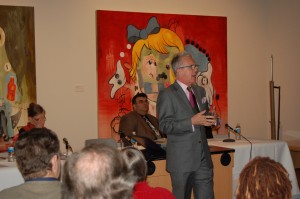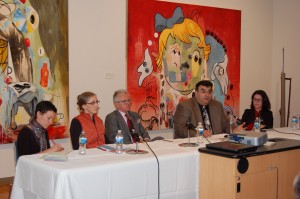Notes from the Visual Arts Forum at Haggerty
 Things heard and observed at the State of Art: Open Forum about the Visual Arts in Wisconsin held at the Haggerty Museum of Art on March 26, 2009
Things heard and observed at the State of Art: Open Forum about the Visual Arts in Wisconsin held at the Haggerty Museum of Art on March 26, 2009
Forum participants: Jane Simon, Curator of Exhibitions, Madison Museum of Contemporary Art. Polly Morris, Director of Development, Marketing & Outreach at UWM Peck School of the Arts, Milwaukee Arts Board member. George Tzougros, Executive Director, Wisconsin Arts Board. Debra Brehmer, arts writer, owner of Portrait Society Gallery and art history instructor at the Milwaukee Institute of Art and Design
*
I arrived early to look at the Current Tendencies: Ten Artists from Wisconsin survey show. I am impressed and captivated, mostly at the transformation Haggerty itself has undergone in the past year to expand its space and scope. Gone are the permanent collection pieces that often featured religious themes and replaced with more provacative work.
The selections in this show seemed to be calculated, however, to find individuals set to specific voices. In one room, beaded dolls from Anne Kingsbury seem Native American. The next room has giant paintings of nude Black males by George Williams, Jr. The next, minimalist folk art objects by the late Peter Bardy. Another incredible room created by Jennifer Angus is covered with faux-wallpaper insects and 3D bugs over all four walls. One more room contains paper cutting art by Xiaohong Zhang. The other five artists are less distinct in perspective (except maybe Sonja Thomsen’s Lacuna, which could be described as Caucasians in Wisconsin based on content and concept) but they are all just as compelling.

The evening starts as the room nearly fills. Haggerty Museum Director Walter Mason gives an opening speech about questions circling visual thinking and then gives directions on what will happen here. There is to be introductions followed by opening up to the floor to queries. He makes an aside, seemingly joking, that there will be no complaining. This falls on deaf ears as the conversation will immediately devolve to subjects of funding, exposure, and the lack of critical evaluation of local art.
If I had a chance to ask a question, it would have been more like “so what have you seen lately and how did it move you?” I always attend these events hoping to talk about art, but they always end up being about tangential subjects to art itself.
Introductions start with Debra Brehmer, who takes up the most time initially with a clever photoshopping of a crucifixion painting showing a trinity of artist, dealer, and collector along with bystanders representing media, educators, and others.
As the former editor of Art Muscle, Brehmer laments the present-day lack of a print publication that could showcase and critique local art (like Art in America does in a national publication). Evoking Art Muscle’s name will happen again and again by the audience, who may not understand the financial difficulty with putting out a physical edition of something in a period of skyrocketing paper costs and plummeting ad revenue.
George Tzougros is next. He’s thankful for a job that takes him out to where art is actually being made in Wisconsin. He’s also aware of the pain of major outlets closing and the difficulties acquiring funds through federal and state means. There will be some nice stimulus coming but also some loss of space.
Tzougros says that some of his favorite new works are being hung at rural coffeeshops. Each of them, he says, has something to comment on what is going on around them and in the world.
Polly Morris introduces herself, acknowledging that most people probably know her from the extensive efforts she made on the Nohl Fellowships and INOVA. It really is probably the most generous program for artists and exposure in the state. It’s also one of the few of its kind.
Sitting on the Milwaukee Arts Board, she notes that they always wished to have more contact with the public. She then takes a moment to plug the new INOVA show. Morris finally notes how happy she is with the “confluence of investigations into art” in our area, including the Haggerty survey show.
The last member of the forum panel is Jane Simon, curator at the remarkable contemporary art space in Madison. She immediately notes what a weird time it is for the arts, and being an American in general. The recession has definitely forced her to be more creative with finance, and hopes we look back in ten years thinking how it was a helpful time – learning to make hard choices.

40 of the 90 minutes allotted have passed. Mason asks for opening questions without a subject cue, and many hands shoot up. The audience is actually an impressive mix of area gallery owners, artists, curators, educators, program directors and others. The most vocal are unfortunately the most distressed about the current state of arts recognition and finance, leaving the panel to counter with positivity or at least sympathy for most of the time.
If I could Cliff Notes a particular conversation, it would go like this: “I mean, that’s not good, is it?” “No, no, you’re right. We’re on the same page and wish it was different.” “Are you doing something about it?” “We’re trying.”
The first question is about Congress disrespecting the arts, but at least they gave $50 million. Of that amount, Wisconsin will get around $318,000. This will then be distributed to organizations ready with the paperwork and who know its way around the system. But Tzougros notes that there are a lot of different organization structures out there that won’t get it. Morris also concurs that new forms are emerging that will be ineligible. Some will have consider crossing the line between profit and non-profit (as the film scene has done) to make it happen.
The crowd repeatedly bemoans the lack of coverage in media (like T.V. and print), but more specifically complain about the lack for one central online location to read academic critique, look at show openings, and network among artists. The word ‘fractured’ is often used, as everyone feels disconnected from each other.
The more appropriate term might have been ‘fragmented’. While no one can agree on one site for Wisconsin visual arts site to host it all, it is the nature of the internet to disseminate from one source to many more sites. There is not a lack of online resources for visual arts in our area, but a lack of awareness of each of them and not enough time to hit all the sites. As for deep discourse or essays about local art, Brehmer asserts that there is still no substitute for a print version but the right dynamic to run one is difficult.
Cynthia Henry from AYZHA Fine Arts voices her concern about diversity having a voice in the visual arts scene, and in fact may be the only African-American in the room from my vantage point. She wants to know what is the outreach level among the panel. Tzougros acknowledges that they aren’t a good representative of the faces, but they regularly go out to find them. He’s grateful she has brought her publication and herself to the forum, so they can start to bridge gaps in creating forums.
Worried audience worries about Waukesha’s lack of inclusion, even though it has a robust scene the funding for art walks there has dwindled and exposure had dried up. Morris reminds her later that her county is one of the four eligible for the Nohl Fellowships (my neighboring county, Racine, still is not eligible).
Jane Simon remembers some corporation art loans conducted in Madison under the auspices that the space was viable and properly lit. She’s frustrated that some corporations’ HQs purchase art but others don’t.
A Bed and Breakfast owner says he features local art at his location, but can’t always tell out-of-town guests where to find good stuff. The Gallery Night publication put out by the East Town and Historic Third Ward Association is mentioned. No one states that the publication is mostly only good for that night, a few areas, and lists only those that list with the Association.
One MIAD gallery director in the audience notes that at least 3,000 people come for Gallery Night, and even more must come out for the quarterly event. So people must be aware that art is out there.
Someone wonders why the business model for artists doesn’t work. The lady in front of me whispers to a friend, “because artists suck at marketing”. As an artist myself, I can attest to that.
Jane Simon notes that she had many misconceptions about Wisconsin upon moving here from New York, but she was surprised to see what kind of work was done. Simon was also amazed at the 2007 Wisconsin Triennial in Bayfield (think tip of the mitten that makes up our state) that artists could be viable in a remote town like that and have a national career.
One well-known and cantankerous artist finally puts it out there: “what can you do for me?” It’s not clear if he is joking. He laments there is no new art out there. Finally, I interject for the first time all night with a listing: Cedar Block events, Armoury Gallery, Luckystar, Borg Ward, WPCA— “TOO SMALL,” he exclaims.
I slump back into my seat and the room is silent for two seconds.
George Tzougros gets the last word, stating that too many are not taking advantage of the incentives offered (presumably through the entities like the Wisconsin Arts Board). He hopes that models like the recent progression in local film and T.V. production, or programs like the new Artists’ Access to Healthcare in Duluth, Minnesota will make there way here.
Wally Mason concludes with the hope that this forum would be only the first in a series of conversations. The room starts buzzing as the networking amongst participants and audience members begins.
Art
-
It’s Not Just About the Holidays
 Dec 3rd, 2024 by Annie Raab
Dec 3rd, 2024 by Annie Raab
-
After The Election Is Over
 Nov 6th, 2024 by Annie Raab
Nov 6th, 2024 by Annie Raab
-
The Spirit of Milwaukee
 Aug 30th, 2024 by Annie Raab
Aug 30th, 2024 by Annie Raab





















What I heard last night was a lot of passion, frustration and kudos and acknowledgement to those that have contributed to the WI art scene.
We do need to be more connected. I would like to see some of these people that were there last night come back together with the purpose of working out a work plan to put some of the things that we touched on last night into action. It is easy to talk, much harder to act. There were a lot of good ideas discussed last night that could be examined and put into action. If we do nothing we only have ourselves to blame. Action is a powerful thing.
who was the “well-known and cantankerous artist?” Roy Staab?
journalistic integrity and respect for the artist prevents me from saying.
Thank you for such a direct report of last evening’s ‘forum’. I have recently discovered Third Coast Digest and am finding this a new way to read the ‘goings-on’ of the area and will continue, even though I was referred as an “Indignant audience member”. Very rarely do speak at public meetings but I will do so with great caution in the future since my words and attitude seem to have been mis-represented in your review.
this is old news, but there are many who think the Nohl Fellowships should be changed so one or two artists receive a significant sum of money rather than a slew of artists divying up the spoils. I like this idea, but nothing will come of it.
Brian: you sure resembled Mike Brenner in your photo. I can tell you from experience (I purchased Art Muscle from Deb Brehmer) that producing print media is way expensive…it was even more so a decade ago than it is now. I had to close because of the escalating costs. And guess what..not one person came forward to take over the reins. I told them how it could actually make money, but no one wanted to work hard to make it happen. Likely, these are many of the same who showed up at the Haggerty to whine about the visual arts
in this state. There were plenty of artists who were eager to get their name in Art Muscle, but when push came to shove, there were none who wanted the nuts and bolts effort to keep it alive.